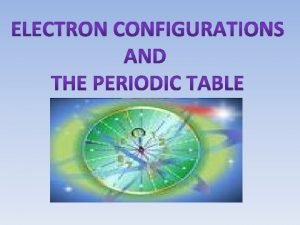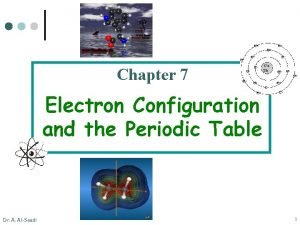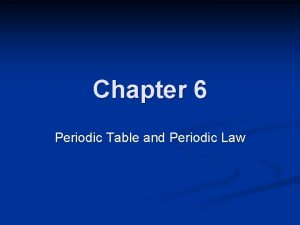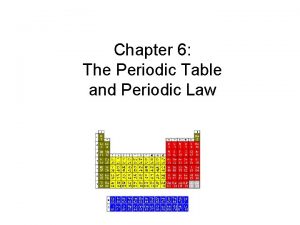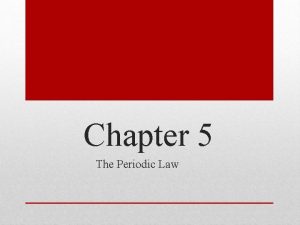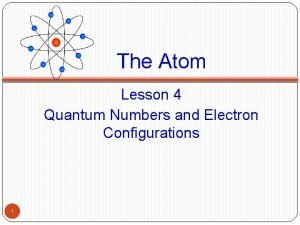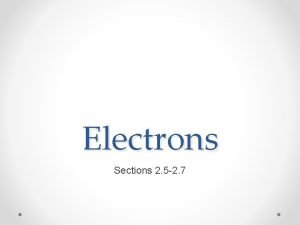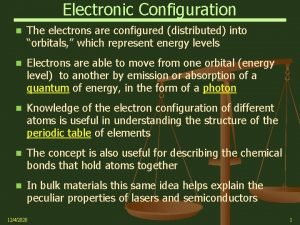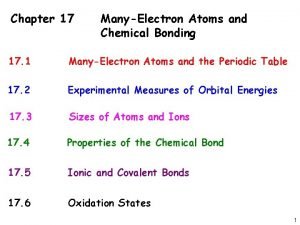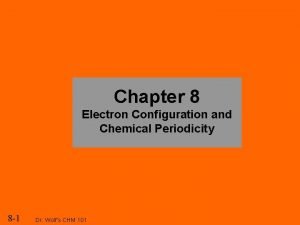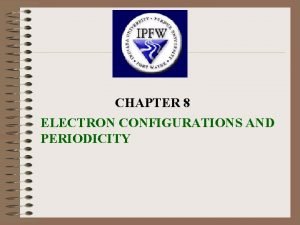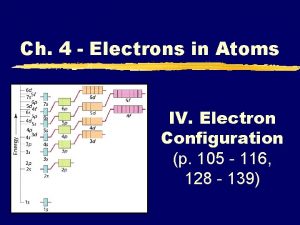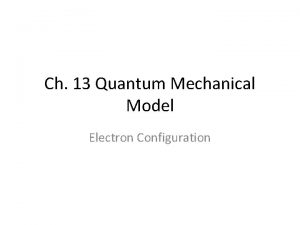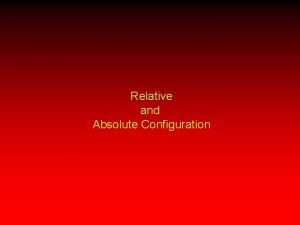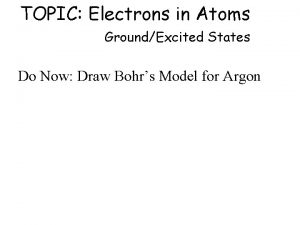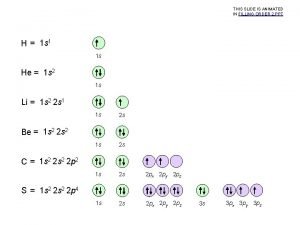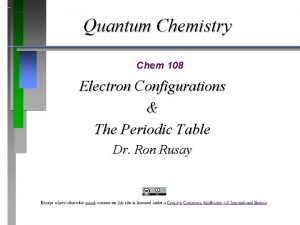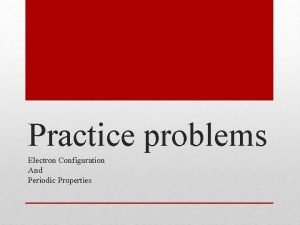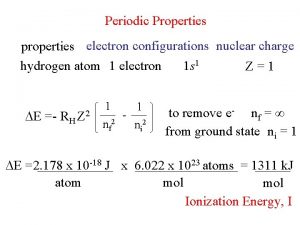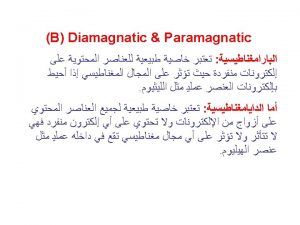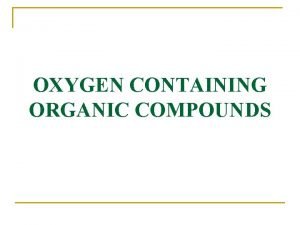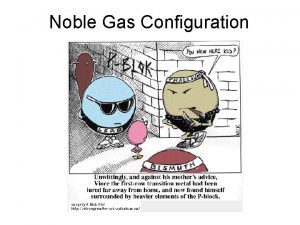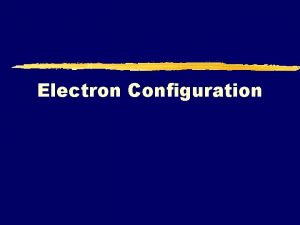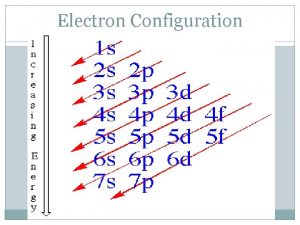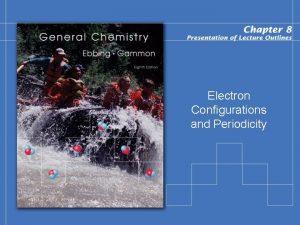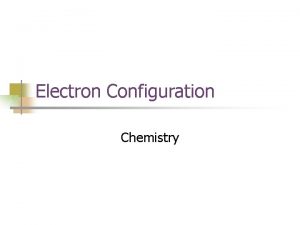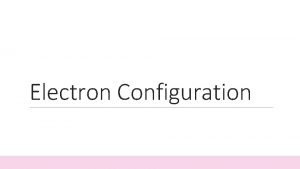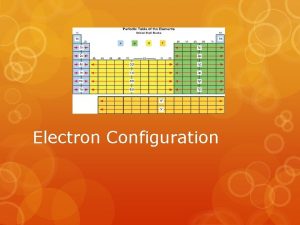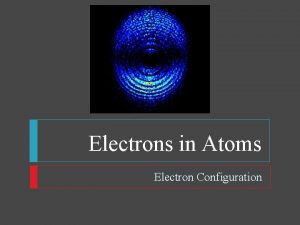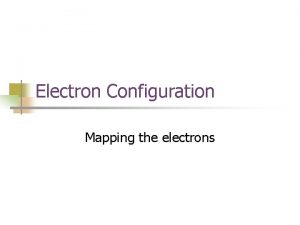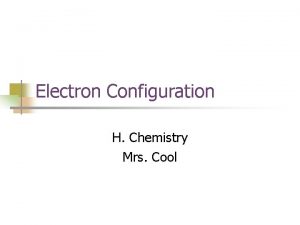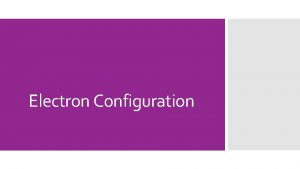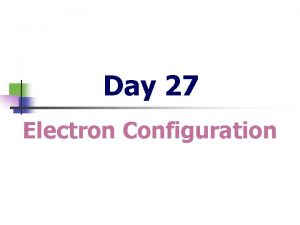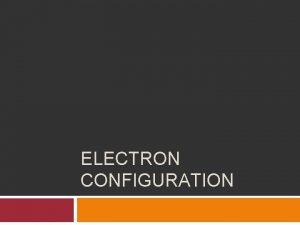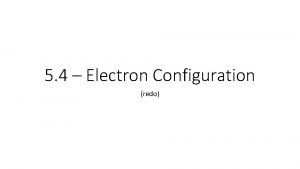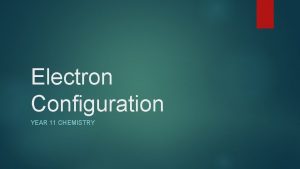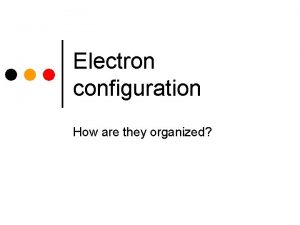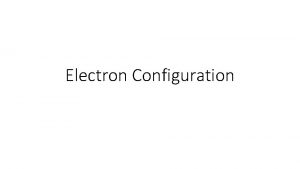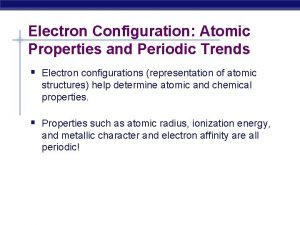The Periodic Law Electron Configuration and the Periodic




























- Slides: 28

The Periodic Law Electron Configuration and the Periodic Table

Electron Configuration and the Periodic Table Objectives Explain the relationship between electrons in sublevels and the length of each period of the periodic table Locate and name the four blocks of the periodic table and explain the reasons for these names Discuss the relationship between group configurations and group numbers Describe the locations in the periodic table and the general properties of the alkali metals, the alkaline-earth metals, the halogens, and the noble gases

Electron Configuration and the Periodic Table Period and Blocks of the Periodic Table of the Elements are arranged vertically in the periodic table in groups that share similar chemical properties Elements are also organized horizontally in rows, or periods The length of each period is determined by the number of electrons that can occupy the sublevels being filled in that period The periodic table is divided into four blocks, the s, p, d, and f blocks. The name of each block is determined by the electron sublevel being filled in that block

Electron Configuration and the Periodic Table Period Length and Sublevel Filled

Electron Configuration and the Periodic Table Blocks of the Periodic Table Based on Sublevel

Electron Configuration and the Periodic Table Families of the Periodic Table of the Elements Alkali Metals Alkaline-Earth Metals Transition Metals Rare Earth Metals Other Metals Metalloids Non Metals Halogens Noble Gases

Electron Configuration and the Periodic Table Hydrogen and Helium Hydrogen has an electron configuration of 1 s 1, but despite the ns 1 configuration, it does not share the same properties as the elements of Group 1 Hydrogen is a unique element Like the Group 2 elements, helium has an ns 2 group configuration. Yet it is part of Group 18 Because its highest occupied energy level is filled by two electrons, helium possesses special chemical stability

Electron Configuration and the Periodic Table Alkali Metals The elements of Group 1 of the periodic table are known as the alkali metals lithium, sodium, potassium, rubidium, cesium, and francium In their pure state, all of the alkali metals have a silvery appearance and are soft enough to cut with a knife

Electron Configuration and the Periodic Table Alkaline-Earth Metals The elements of Group 2 of the periodic table are called the alkaline-earth metals beryllium, magnesium, calcium, strontium, barium, and radium Alkaline-earth metals are less reactive than the alkali metals, but are still too reactive to be found in nature in pure form

Electron Configuration and the Periodic Table Period and Blocks of the Periodic Table of the Elements Sample Problem A. Without looking at the periodic table, identify the group, period, and block in which the element that has the electron configuration [Xe]6 s 2 is located Without looking at the periodic table, write the electron configuration for the Group 1 element in the third period. Is this element likely to be more reactive or less reactive than the element described in (A)

Electron Configuration and the Periodic Table Period and Blocks of the Periodic Table of the Elements Sample Problem Solution A. The element is in Group 2, as indicated by the group configuration of ns 2 It is in the sixth period, as indicated by the highest principal quantum number in its configuration, 6 The element is in the s block

Electron Configuration and the Periodic Table Period and Blocks of the Periodic Table of the Elements Sample Problem Solution B. In a third-period element, the highest occupied energy level is the third main energy level, n = 3. The 1 s, 2 s, and 2 p sublevels are completely filled This element has the following configuration: 1 s 22 p 63 s 1 or [Ne]3 s 1 Because it is in Group 1, this element is likely to be more reactive than the element described in (a), which is in Group 2

Electron Configuration and the Periodic Table Transition Metals The d-block (groups 3 – 12) elements are metals with typical metallic properties and are often referred to as transition elements

Electron Configuration and the Periodic Table Period and Blocks of the Periodic Table of the Elements Sample Problem The number of the highest occupied energy level is 5, so the element is in the fifth period There are five electrons in the d sublevel, which means that it is incompletely filled. The d sublevel can hold 10 electrons. Therefore, the element is in the d block For d-block elements, the number of electrons in the ns sublevel (1) plus the number of electrons in the (n − 1)d sublevel (5) equals the group number, 6 This Group 6 element is molybdenum. The others in Group 6 are chromium, tungsten, and seaborgium

Electron Configuration and the Periodic Table Period and Blocks of the Periodic Table of the Elements Sample Problem Solution An element has the electron configuration [Kr] 5 s 24 d 4. Without looking at the periodic table, identify the period, block, and group in which this element is located. Then, consult the periodic table to identify this element and the others in its group

Electron Configuration and the Periodic Table Metalloids, Other Metals, Non Metals, Halogens, N Gases The p-block elements consist of all the elements of Groups 13– 18 except helium The p-block elements together with the s-block elements are called the main-group elements The properties of elements of the p block vary greatly

Electron Configuration and the Periodic Table Metalloids Having properties of both metals and non-metals are the metalloids Metalloids have a metal-like appearance and can conduct heat and electricity under certain conditions

Electron Configuration and the Periodic Table Other Metals Other metals elements are elements that are ductile and malleable, but they are not the same as the transition elements aluminum, gallium, indium, tin, thallium, lead, bismuth All of these elements are solid, have a relatively high density, and are opaque

Electron Configuration and the Periodic Table Non Metals Non-metal elements are not able to conduct electricity or heat very well. As opposed to metals, as solids, are nonmetallic elements are very brittle, and cannot be rolled into wires or pounded into sheets carbon, nitrogen, oxygen, phosphorus, sulfur, selenium

Electron Configuration and the Periodic Table Halogens The elements of Group 17 are known as the halogens fluorine, chlorine, bromine, iodine, and astatine The halogens are the most reactive nonmetals and they react vigorously with most metals to form examples of the type of compound known as salts

Electron Configuration and the Periodic Table Noble Gases Elements of group 18 are known as the noble gases neon, argon, krypton, xenon, and radon The noble gases are the most unreactive elements and all reside as gases in their normal state

Electron Configuration and the Periodic Table Period and Blocks of the Periodic Table of the Elements Sample Problem Without looking at the periodic table, write the outer electron configuration for the Group 14 element in the second period. Then, name the element, and identify it as a metal, nonmetal, or metalloid

Electron Configuration and the Periodic Table Period and Blocks of the Periodic Table of the Elements Sample Problem Solution The group number is higher than 12, so the element is in the p block The total number of electrons in the highest occupied s and p sublevels is therefore equal to the group number minus 10 (14 − 10 = 4) Two electrons are in the s sublevel, so two electrons must also be present in the 2 p sublevel, The outer electron configuration is 2 s 22 p 2 The element is carbon, C, which is a nonmetal

Electron Configuration and the Periodic Table Lanthanides and Actinides In the periodic table, the f-block elements are wedged between Groups 3 and 4 in the sixth and seventh periods The first row of the f block, the lanthanides, are shiny metals similar in reactivity to the Group 2 alkaline metals The second row of the f block, the actinides, are between actinium and rutherfordium. The actinides are all radioactive Their position reflects the fact that they involve the filling of the 4 f sublevel

Electron Configuration and the Periodic Table Period and Blocks of the Periodic Table of the Elements Sample Problem Name the block and group in which each of the following elements is located in the periodic table. Then, use the periodic table to name each element. Identify each element as a metal, nonmetal, or metalloid. Finally, describe whether each element has high reactivity or low reactivity A. [Xe] 6 s 24 f 145 d 8 B. [Ne]3 s 23 p 5 C. [Ne]3 s 23 p 6 D. [Xe] 6 s 24 f 6

Electron Configuration and the Periodic Table Period and Blocks of the Periodic Table of the Elements Sample Problem Solution A. The 4 f sublevel is filled with 14 electrons. The 5 d sublevel is partially filled with eight electrons. Therefore, this element is in the d block The element is the transition metal platinum, Pt, which is in Group 10 and has a low reactivity B. The incompletely filled p sublevel shows that this element is in the p block. A total of seven electrons are in the ns and np sublevels, so this element is in Group 17, the halogens The element is chlorine, Cl, and is highly reactive

Electron Configuration and the Periodic Table Period and Blocks of the Periodic Table of the Elements Sample Problem Solution C. This element has a noble-gas configuration and thus is in Group 18 in the p block The element is argon, Ar, which is an unreactive nonmetal and a noble gas D. The incomplete 4 f sublevel shows that the element is in the f block and is a lanthanide. Group numbers are not assigned to the f block The element is samarium, Sm. All of the lanthanides are reactive metals

Electron Configuration and the Periodic Table Period and Blocks of the Periodic Table of the Elements http: //www. ptable. com/
 Electron configuration vs noble gas configuration
Electron configuration vs noble gas configuration Periodic table electron configuration
Periodic table electron configuration Isoelectronic series
Isoelectronic series Chapter 6 the periodic table
Chapter 6 the periodic table The periodic table and periodic law chapter 6
The periodic table and periodic law chapter 6 Chapter 5 periodic law
Chapter 5 periodic law Quantum numbers and electron configuration
Quantum numbers and electron configuration 1s 22 s22 p63 s23 p64
1s 22 s22 p63 s23 p64 N and l electron configuration
N and l electron configuration Copper subshell configuration
Copper subshell configuration N and l electron configuration
N and l electron configuration Orbital diagram for k
Orbital diagram for k C n o f electron affinity
C n o f electron affinity Stability and electron configuration ch 4
Stability and electron configuration ch 4 E=h x v
E=h x v Newton's first law and second law and third law
Newton's first law and second law and third law Newton's first law and second law and third law
Newton's first law and second law and third law Absolute vs relative configuration
Absolute vs relative configuration Relative vs absolute configuration
Relative vs absolute configuration Absolute vs relative configuration
Absolute vs relative configuration Excited state electron configuration
Excited state electron configuration Orbital diagram for uranium
Orbital diagram for uranium Oganesson electron configuration
Oganesson electron configuration Electron configuration problems
Electron configuration problems Methene
Methene Zeff of h-
Zeff of h- Unpaired electrons
Unpaired electrons Electron configuration for oxygen
Electron configuration for oxygen Noble gases configuration
Noble gases configuration

